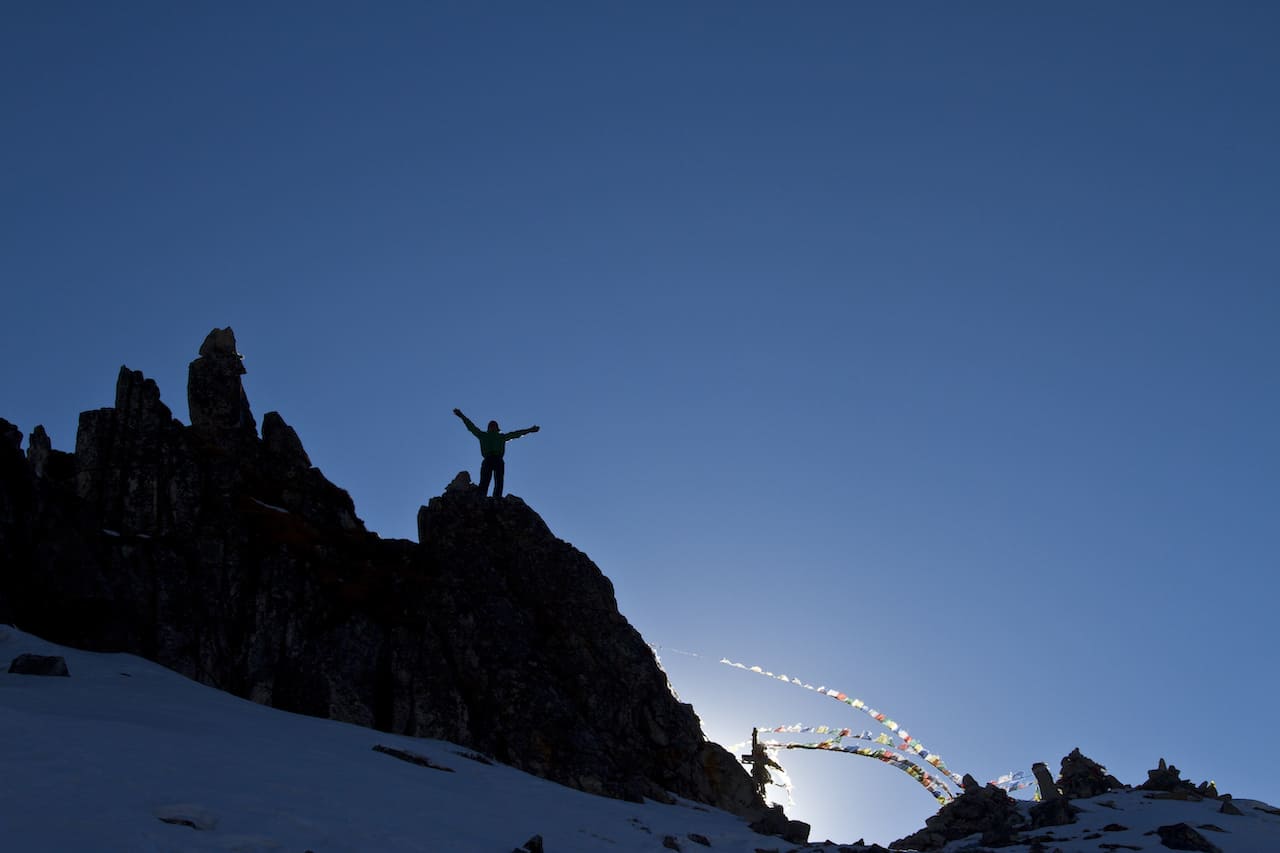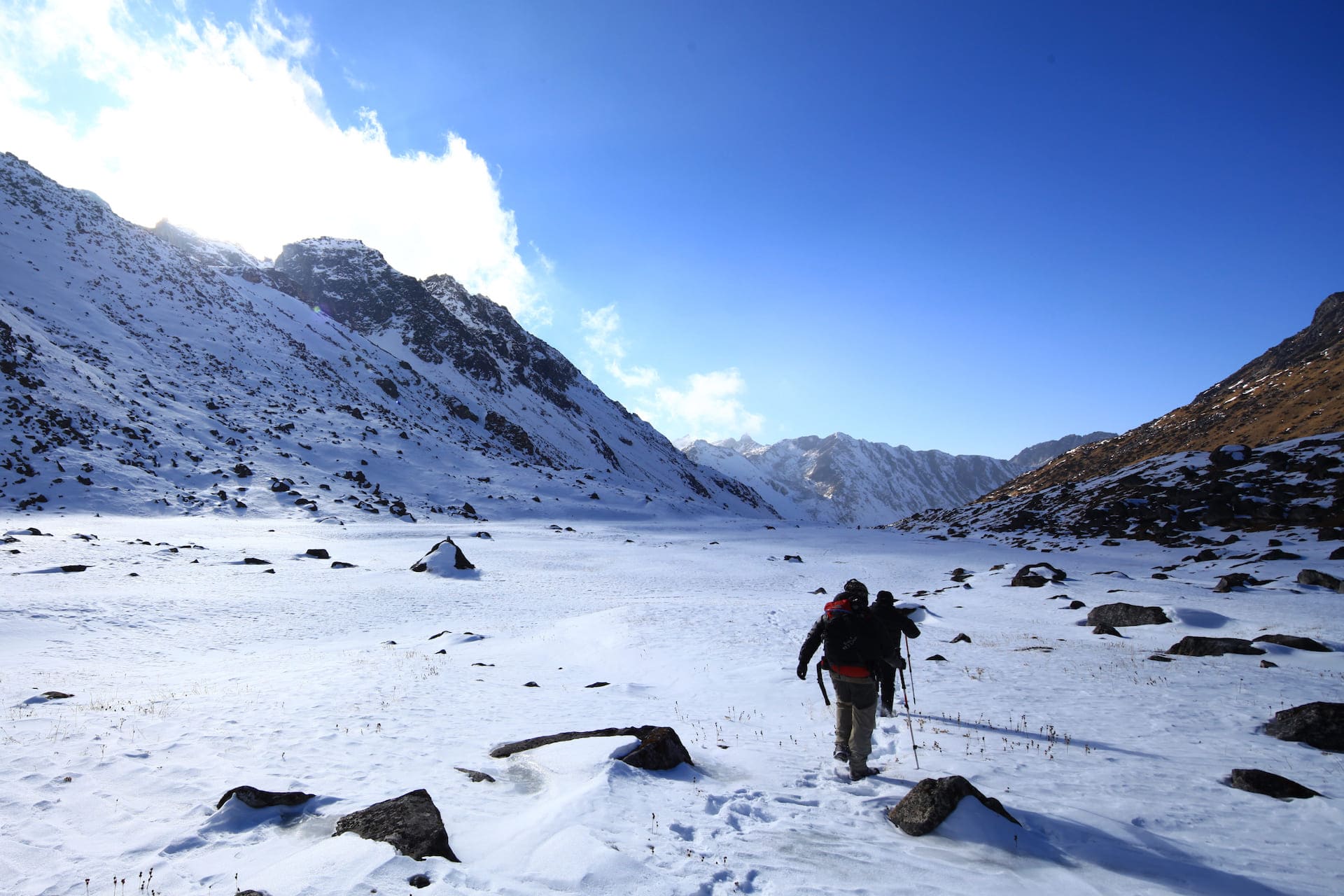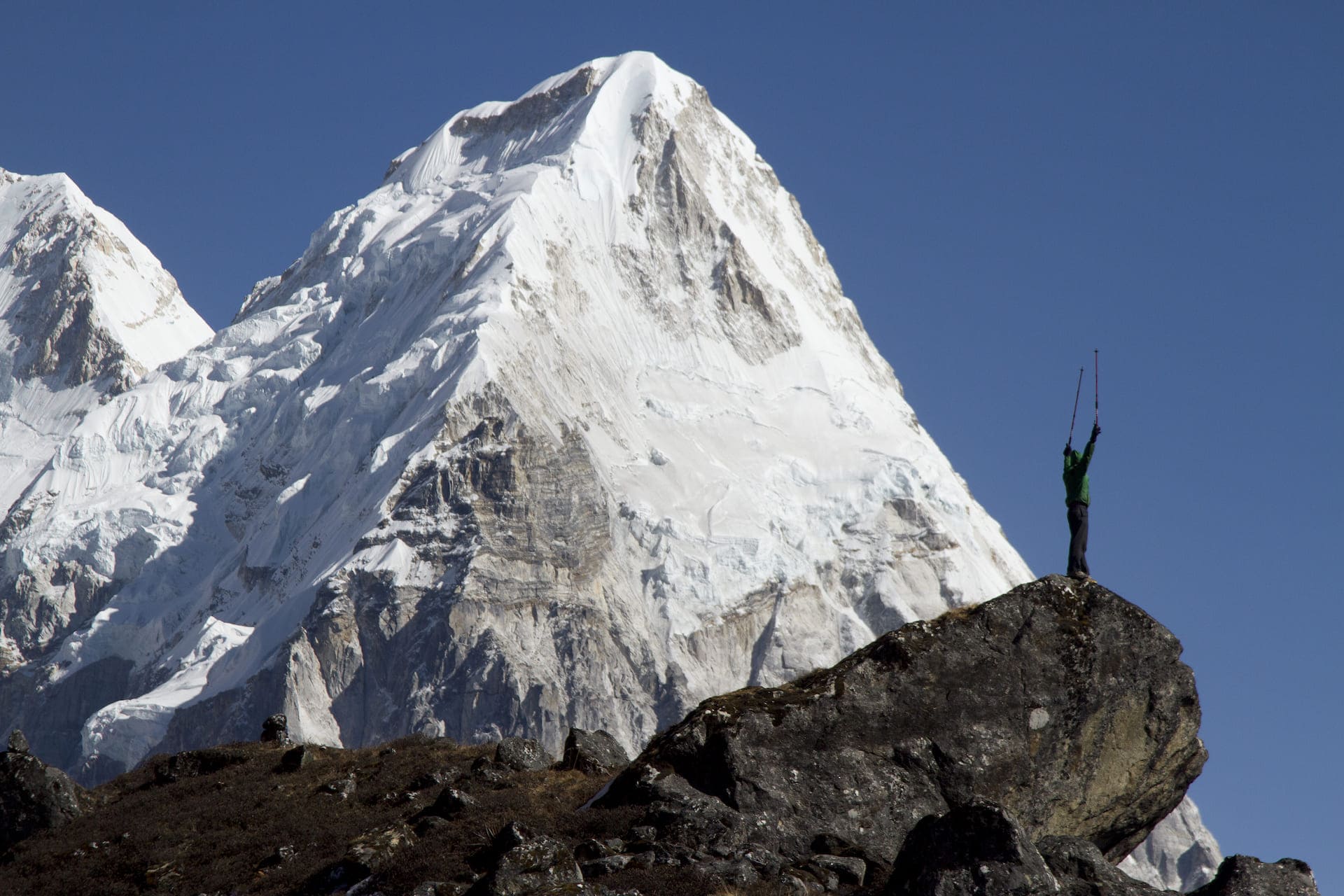You can contact us by e-mail or phone
from uk
01405 862917
outside uk
+44 1405 862917
01405 862917
+44 1405 862917

Off Grid Trekking in Nepal
Snow Cat Travel - A UK registered trade mark
Escaping the crowds to enjoy off the beaten track trekking or off grid treks in Nepal isn't that difficult. Around 80% of all trekkers are heading for Annapurna, or the Everest trekking areas.
The two busiest treks are Annapurna Base Camp and Everest Base Camp.
So to avoid the crowds and enjoy much quieter Himalayan trails if you avoid those two regions, then the discerning 20% have a lot of choice....the rest of the Nepal Himalayas!
Here's five of the best off grid treks in Nepal

Dolpo and the trek to Shey Gompa
Remote, isolated, and by and large unchanged by the few that venture here as a result. The mystical land of Dolpo was both the setting for the Peter Matthiessen classic 'The Snow Leopard' and the Eric Valli film 'Himalaya'. Shey Gompa, Phoksundo Lake, and the 'Demons Trail' await the intrepid adventure traveller on this very challenging, fascinating circuit trek to Inner Dolpo.

One of the longer treks in Nepal With several 5000-metre passes to cross and snow conditions likely, there are many long, challenging days walking at high altitudes. Indeed, this trek is often called 'The Snow Leopard Trek'. Thus, this rarely visited magical land where the Bon Po religion thrives beneath the 'Crystal Mountain' will likely remain the domain of the determined, experienced (and very fit) trekker for many years to come. This circuit trek of Dolpo visits the bejewelled Phoksundo Lake before tackling the 'Demons Trail' and then over the Kang La to the restricted area of Inner Dolpo, for which special permits are required. Leaving Inner Dolpo by crossing the Shey La and down through the Tarap Chu, the traditional dress of the people of Dho Tarap is encountered on this journey through the realm of the snow leopard.
The Tsum Valley Trek
Initially following the Manaslu Circuit Trek, you then take a detour and trek back in time to a hidden valley where a Tibetan way of life remains largely undisturbed and amongst glorious mountain scenery too.

The Tsum Valley system lies behind the Ganesh Himal and is an expansive, lesser-travelled valley often bypassed by those attempting the more familiar Manaslu Circuit Trek. Indeed, this trek can readily be combined with the Manaslu Circuit Trek too. This linear trek, which ultimately leads to the remote Mu Gompa, a “stone's throw” from the mountainous border with Tibet, starts and ultimately returns via the lower section of the Manaslu Circuit Trek. The Tsum Valley Trek splits away by turning away from the main Manaslu trail to head in a totally different direction and into a world seldom seen. In season, intrepid locals come in search of the highly prized Yarsagumba and up until recently, a total absence of teahouses deterred many trekkers too. Indeed, this area could still be considered “restricted access”, although the recent addition of a handful of rather simple and basic teahouses makes the trek a more appealing short Nepal trek proposition. Needless to say, for the trekkers bold enough to explore the Tsum Valley, an almost secret world of tiny, authentic, mountain villages can be found beneath spectacular mountain scenery, where the influence of Tibetan Buddhism remains traditional and by and large unchanged.
The Dhaulagiri Circuit Trek
A serious and committed undertaking with a number of very tough trekking days at high altitudes. The realm of the experienced trekker only. A journey into a true Himalayan wilderness that goes beyond the definition of spectacular.

This is perhaps the most challenging circuit trek in Nepal.
Previous experience with high altitude and lengthy trekking is absolutely essential for this specialist trek. There are some very arduous and long walking days as you head higher and deeper and trek into a Himalayan mountain wilderness. Indeed, there are no permanent settlements for several days on this trek. The crux of the Dhaulagiri Circuit Trek is the crossing of the 'French Pass, and it's a very tough crossing that includes some exposure (fixed lines may be deployed), some rough scree, moraine, and snow-covered slopes. The use of crampons and a walking ice axe will be necessary, and your previous mountain walking experience and skills must be sufficient to be capable and familiar with the necessary equipment and conditions likely to be encountered. The rewards for the experienced trekker are immense. A varied terrain experience, trekking off the beaten track, remote hill villages, spectacular close-up views of Himalayan giants, and the satisfaction of mountain wilderness trekking
Makalu Base Camp Trek
A truly exciting teahouse trek deep into the lesser-travelled Himalayas The Makalu Base Camp Trek is an epic "out there" journey up through the Makalu Barun National Park with awe-inspiring close-up views of the world's fifth highest peak that define the meaning of dramatic.

At 8416m high, Makalu is the world’s fifth-highest mountain and one of the most imposing and spectacular. Indeed, the day when you walk to Makalu Base Camp itself must surely be one of the most incredible trekking days anywhere in the world. The trek to mighty Makalu is often regarded as one of Nepal’s best-kept secrets. Very tough trekking and the fact that it’s not as easily accessible as the likes of the Annapurna and Everest regions meant that very few trekkers followed in the footsteps of renowned explorer Eric Shipton and explored the magnificent Makalu Barun National Park. Until recently, the trek to Makalu Base Camp was essentially wild camping, expedition style. Nowadays, it is possible to undertake the Makalu Base Camp trek and overnight in trekking lodges (teahouses), although these are much simpler affairs than those found in the more popular trekking regions of Nepal. A very good level of fitness and previous high-altitude trekking experience are essential.

On one day alone, there are the Shipton La and three other high passes to navigate. But efforts are rewarded on this rather varied, linear trek from circa 700m to over 5000m and back again with magnificent mountain scenery, as well as authentic hill villages along the way to enjoy before heading higher into a wild and high mountain wilderness. Reaching a view point above Makalu Base Camp, there are outlandish views of major peaks from Baruntse (7129m) to Chamlang (7319m) and beyond to Lhotse (8516m) and the highest of all, Everest at 8848m. But the real star of the show is Makalu, which completely demands your attention with its brutish yet commanding presence. Even the journey to the trailhead can be quite a challenge, but it adds to the sense that this is real, adventurous Himalayan trekking. Autumn and late Spring are usually the optimum periods to attempt this challenging trek, as during the winter months a high risk of heavy snow means the high passes may not be crossable and also the fact that the teahouses may not be operational.
Kangchenjunga Base Camp Trek - North and South
One of the most dramatic and demanding Himalayan trekking adventures involves both the North and South Base Camps of remote Kangchenjunga, the world’s third-highest peak. In a word, “SPECTACULAR”.

An epic, true Himalayan trek to Kangchenjunga's North and South Base Camps
The ultimate Kangchenjunga Trek is exactly that, as it visits both Kangchenjunga North Base Camp and Kangchenjunga South Base Camp, making for a lengthy and very demanding trek. However, it is also possible to shorten the total duration to just one of the two base camps. But, given the effort in terms of travel just to get from Kathmandu to the far east of Nepal, where the massif of Kangchenjunga is, if you have the time, then combining both base camps is without doubt just about as spectacular as Himalayan treks get.

This lesser-trodden region of Nepal remains unspoilt by tourism, and although the trekking is very challenging and at very high, sustained altitudes, the rewards are immense. From both base camps, the imposing bulk of Kangchenjunga towers right above you. There are high passes to cross, glacial moraines to negotiate, and a mountain wilderness to savour, as well as tiny, authentic hill villages to appreciate too. In fact, this trek has just about everything.

But, of course, it is a serious undertaking too, most certainly not for novices, and remains the domain of the experienced trekker with a good level of fitness only. For those who dare, this is Himalayan adventure at its very, very best.

Taking into account the travelling and the trekking you really need just over 3 weeks to complete one of the best treks in the entire Himalayas.
If that's too much then an alternative is a Short Kangchenjunga Circuit Trek, which takes just over 2 weeks.
This Kangchenjunga short trek follows a part of the route to Kangchenjunga North Base Camp (Pang Pema), heading up the valley to the Tibetan-influenced mountain village of Ghunsa before heading over high, remote mountain passes and down to exit via the valley system that would ultimately lead to Kangchenjunga South Base Camp. Effectively, the route is a "horseshoe circuit," and along the way, as well as authentic, tiny villages, there is a real sense of being off the beaten track, as the relative inaccessibility of the Kangchenjunga region means far, far fewer people come and trek here.

For the adventurous trekker, the rewards are immense, not least the pleasure of trekking through the landscapes that lie close to the Kangchenjunga Massif and the world's third-highest peak. The remote high mountain ramparts boast a healthy snow leopard population, and that means other Himalayan wildlife too. Himalayan botanists have long held the Kangchenjunga region in high regard, too. As well as unspoilt river valleys, the very challenging two days where you head deep into a mountain wilderness and must negotiate the Sinion La (4670m), the Mirgin La (4690 m), and the Sinelapcha La (4730m) reveal impressive mountain views, including stunning Najju (7771m), distant Everest's lesser-known Kangshung face, and Makalu too.


All rights reserved. Snow Cat Travel is a Registered Trade Mark UK 00003289264



